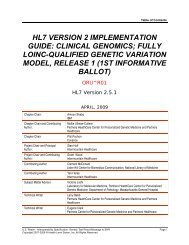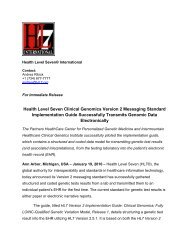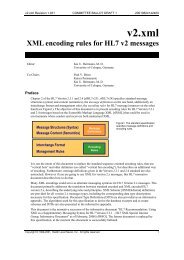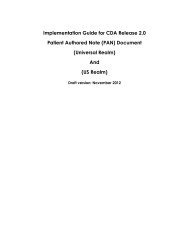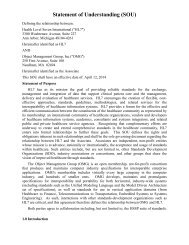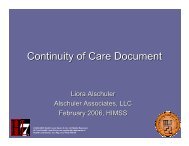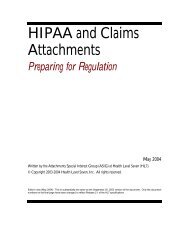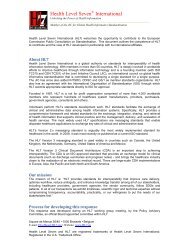HL7 CDA R2 AIS Implementation Guide
HL7 CDA R2 AIS Implementation Guide
HL7 CDA R2 AIS Implementation Guide
You also want an ePaper? Increase the reach of your titles
YUMPU automatically turns print PDFs into web optimized ePapers that Google loves.
<strong>HL7</strong> Additional Information Specification <strong>Implementation</strong> <strong>Guide</strong><strong>CDA</strong><strong>R2</strong><strong>AIS</strong>0000R030This component hasone answer part usingthe LOINC code as thecomponent.This component hasseveral answer parts,each with its ownLOINC codeXPath expressionsidentify where to getthe data.LOINC codeDescription and ValueComponent Answer18671-8ALCOHOL-SUBSTANCE ABUSE18671-8 REHABILITATION TREATMENT PLAN,NEXT PLAN OF TREATMENT TEXT(NARRATIVE)18674-2 ALCOHOL-SUBSTANCE ABUSEREHABILITATION TREATMENT PLAN,LONGEST PERIOD OF SOBRIETY FORABUSED SUBSTANCE (COMPOSITE)This information is stored in an pertaining to the diagnosis addressed by the plan.The XPath Expression to access this information is:/ClinicalDocument//section[code/@code="18674-2"andcode/@codeSystem=$LOINC]//observation[code/@code="18674-2" and code/@codeSystem=$LOINC]18676-7 ALCOHOL-SUBSTANCE ABUSEREHABILITATION TREATMENT PLAN,LONGEST PERIOD OF SOBRIETYThe element of the indicatesthe longest period of sobriety. The @value attributeindicates the length of the period./ClinicalDocument//section[code/@code="18674-2"andcode/@codeSystem=$LOINC]//observation[code/@code="18676-7" andcode/@codeSystem=$LOINC]/value/@valueInclude units for the period of sobriety in the @unitattribute:d daysmo monthswk weeks18675-9 ALCOHOL-SUBSTANCE ABUSEREHABILITATION TREATMENT PLAN,ABUSED SUBSTANCEFigure 2.9-1 Sample Value TableThe columns of the value table are:EntryTypeData Card Response CodeType / Numeric UnitsED 0,1OBS 0,nPQEN 1,11,1 UCUM• LOINC Code Component — this column contains the LOINC code that identifies anattachment component or clinical report category. The LOINC code in bold identifies thequestion or the information being requestedLOINC Code Answer — this column contains the LOINC code that identifies an answer part ofa component or clinical report. If there is a single answer part for the question, the LOINC codeis nearly on the same line as the Component. (Space limitations prevent showing these on thesame line.) If there are multiple answer parts, the LOINC codes for each answer part are in thesubsequent rows of the table, and typically each answer part has a distinct LOINC code.• Description and Value — this column names the component identified by the LOINCcodes. It can also contain instructions on what data to include• Entry Type — this column contains the <strong>HL7</strong> entry type used to record the informationfor the component. This dictates the format of the data in the computer-decision variantof the attachments document as described in section 3.6.• Data Type — this column contains the <strong>HL7</strong> data type of the answer. This dictates theformat of the data in the computer-decision variant of the attachments document asdescribed in section 3.6.• Card (cardinality) — this column gives the minimum and maximum number ofrepetitions. It describes whether the attachment component, clinical report category,answer part, or clinical report component is optional or can repeat. (See 2.10.)• Response Code/Numeric Units – this column defines supporting information relevant tothose attachment components defined as coded elements (CD) or numeric PhysicalThis component mayappear zero or one timein each attachmentdocument.This component will berecorded in anObservation entry.The value of thisanswer part is aphysical quantity.This answer part mustappear exactly once inits component.This illustrates theresponse code set orthe Units of Measurevalues accepted.Page 36March 2007Copyright © 1998-2007Health Level Seven, Inc. All rights reserved.Release 3.0 Draft Standard




